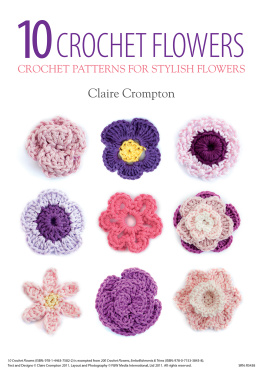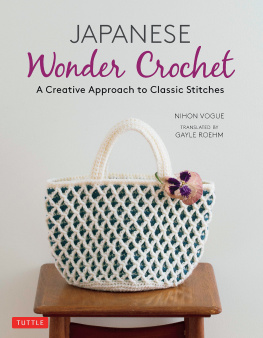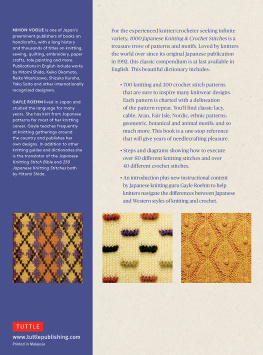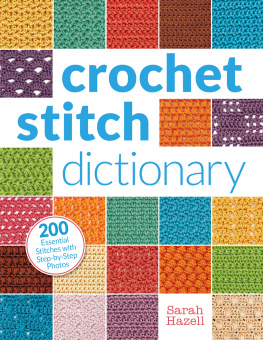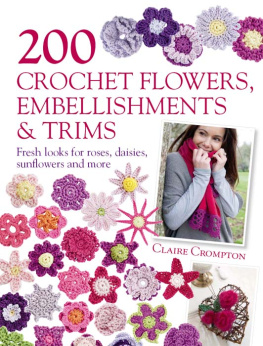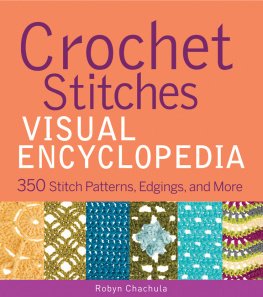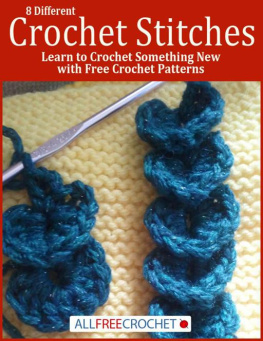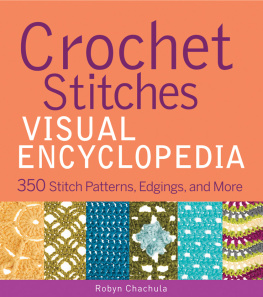Introduction

This book offers a comprehensive collection of crochet stitches, ranging from the very simple to the most complex; the traditional to the innovative. Use it as an inspirational guide to making your own unique crocheted pieces, whether you are creating beautiful garments and accessories for yourself, or stylish adornments for your home.
The book is divided into four sections: Flowers, Trims, Fabrics and Motifs. Each section has its own colour palette to inspire you.
There is a great range of designs in the Flowers section, from the natural to the more flamboyant. Add these to garments and interior items, or use them to make jewellery.
Use the edgings and borders in the Trims section to add an individual touch to your next crocheted or knitted garment or a crocheted trim to ready-made clothing.
Included in the Fabrics section are texture, lace and colour patterns; make them into panels to add to ready-made items or make a patchwork throw of your favourites.
There are three shapes of Motifs: squares, circles and hexagons; traditional alongside new. Ideas for joining motifs to make different items are given later in this section.
Each section starts with a showcase of inspirational projects that offer you different ideas about how to use the designs; use these as a springboard for designing your own versions. For example, the Cushion Panel could be worked in texture or colour stitches. The Patchwork Scarf shows you how to combine any number of stitches together; this uses lace fabrics but you could mix in motifs too.
Each design has a title to help identification. You may recognize some of these and know them by a different name. Neither is right or wrong; its just that different countries have different ways of naming the stitches. For each design there are both written instructions and a chart, making it easier to see how to work each row or round.
If you are unfamiliar with working with charts, you will find some advice later in this section. We also give guidance on how to work from written instructions; understanding abbreviations and shorthand phrases; how to make the correct number in a foundation chain, and how to work more complex stitches such as shells, clusters and popcorns. We also provide a full key to the symbols used in the charts.
Yarn Fibres
There is a huge range of yarns available to inspire the creative crocheter. Yarn can be categorized in various ways, and over the next few pages well discuss colours, textures and weights. When choosing the yarn to use for your project, you should first consider whether it needs to be made of tough fibres to resist wear and tear, such as cotton or wool, or is suitable to be worked in softer fibres, such as silk, because it is more decorative than practical. A childs garment that needs frequent washing should be made in a hard-wearing, machine-washable yarn. Alternatively, a throw that isnt laundered as frequently can be made in less robust yarn, such as handwash-only wool, cashmere or silk. A rug should be worked in tough, thick wool to withstand wear from feet, but a necklace could be made in the most delicate yarns, such as laceweight wools, metallics or fine linen threads. Some fibres cost more than others; throws take a lot of yarn so reserve expensive fibres for smaller items or combine them in stripes or blocks with less costly yarns.
Natural Fibres
Alpaca is spun from the coat of the alpaca, a close relation of the llama. It is a wonderfully soft and lustrous yarn, which has many of the qualities of cashmere but at a more affordable price. It can shed hairs so may be unsuitable for high-use items.
Angora yarn comes from the angora rabbit. A yarn with a high content of angora is very fluffy and sheds hairs. It is usually blended with another fibre to give it stability, making a super-soft yarn.
Cashmere is spun from the hair of the cashmere goat. Pure cashmere yarn is very expensive and best kept for luxury items. When it is blended with another fibre, such as wool, it becomes much more affordable.
Cotton comes from the ball of the cotton plant. It is a heavy fibre, very hard-wearing and is available in a great range of colours. Cotton can be mercerized; this process gives it greater lustre and helps it to take brighter dyes. Matt cotton tends to be more loosely spun.

Mercerized cotton glows with colour, makes crisp, clear stitches and is hard-wearing.
Linen comes from the stem of the flax plant. It is often blended with cotton to soften it. In its natural colour, it has rustic simplicity; when it is dyed it produces soft, dusty shades for understated elegance.
Mohair is spun from the coat of the angora goat. The softer kid mohair is the first or second shearing of a kid goat and is finer than the mohair from the adult goat. It is usually blended with another fibre to give it strength. It is light and airy, but can shed fine hairs.
Silk is a continuous filament secreted by the silkworm larva, which it spins around itself to form a cocoon. This cocoon is unwound and many of these fibres are spun together to form a yarn. Silk has a lustre; it is soft and has a dry feel. Use it blended with cotton or wool to make it harder-wearing.
Wool is spun from the fleece of a sheep; different breeds of sheep give different qualities. Merino wool is very soft, for example, whereas Shetland wool is more hard-wearing. Wensleydale is very lustrous, while Jacob wool is spun in fantastic natural colours. Wool has excellent insulating qualities; it is warm in winter and cool in summer. Wool works up beautifully and can be pulled back and recycled without loss of quality. Wool can be tweed with flecks of contrasting colours, dyed in a solid colour, or kept in its natural shades. Look out for organic or locally produced wool too.

As a fibre, wool cannot be beaten for its warmth, durability and timeless feel.
Blended and Synthetic Fibres
Blended yarns of natural and synthetic fibres combine the natural yarns qualities with the hard-wearing and stable features of the synthetic. Synthetic yarns are hard-wearing and can be spun into wonderful fancy yarns, such as eyelash and ribbon. They take dyes well, especially vibrant and bright colours.

Yarn Colours
Colour is a great inspiration for the creative crocheter. Experiment with vibrant colours together for a striking look, or try a sophisticated palette of natural, muted colours. In this book, each of the four design sections uses a main palette with either contrasting or harmonious highlights. The Flowers section uses the natural contrasts of green, yellow and orange to support the range of dark purple to soft pink. The warm palette of the Trims section uses oranges and yellows, with a sharp contrast of hot pink and lime green. The Fabrics section is designed with a cool palette of greens mixed with harmonious blues. The Motifs are predominantly blue with contrasts worked in lilac and aqua.


